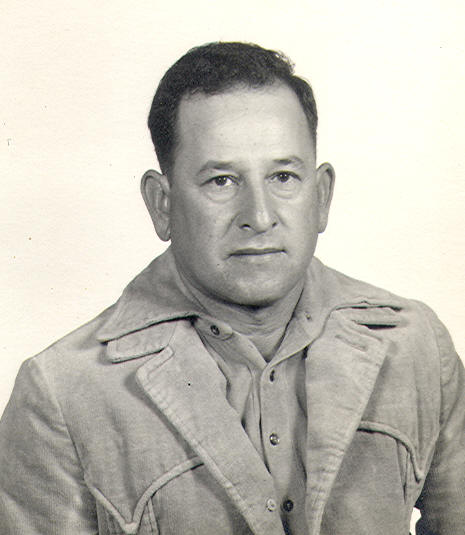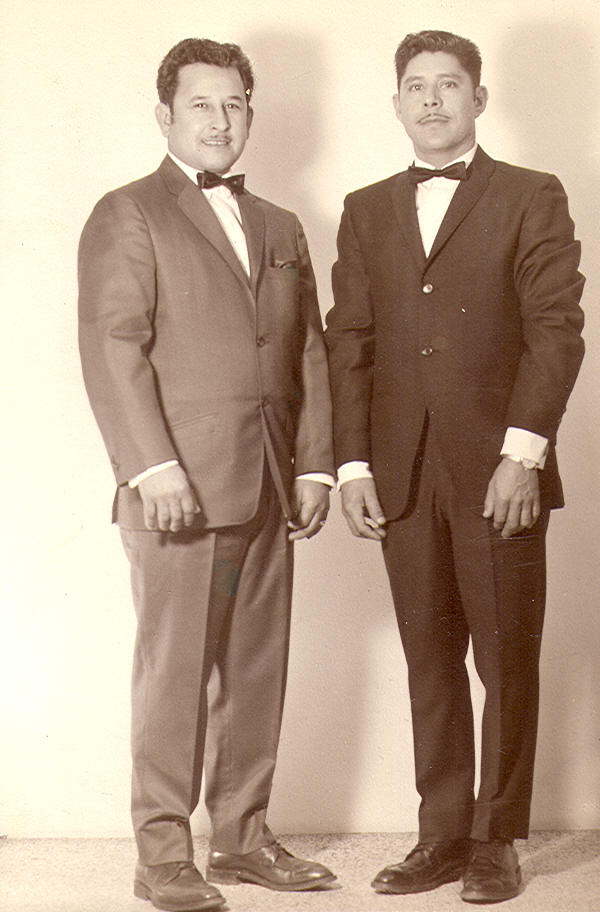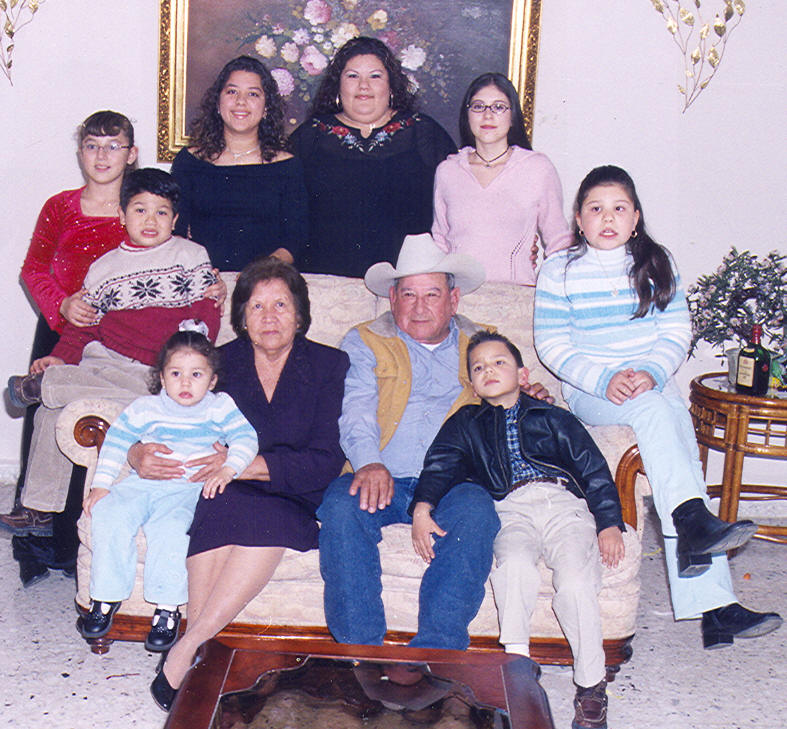Santiago Vasquez Montalvo


I interviewed my grandfather Santiago Vasquez Montalvo Friday morning June 17, 2005 at my aunts home in San Antonio, Texas. He was born January 19, 1934 on a ranch called La Mariposa right outside the town of Melchor Muzquiz, Coahuila, Mexico with the help of a midwife. He was born to Santiago Vasquez a rancher and Herlinda Montalvo a housewife. He was the second oldest of eleven children: Manuel, Santiago (my grandfather), Jesus, Armando, Juan, Guadalupe, Hermelinda, Homero, Maria, Antonieta, and Rosa. They lived in this ranch for over thirty years. When he was twelve years he decided to migrate to the United States in search of a better life. He left to the United States in 1947 and worked throughout his whole time there until he got hurt in 1984. He went back to Mexico nine years after he first left and met my grandmother Graciela. They married and had seven children: Alma Alicia, Juanita R.I.P., Graciela, Maria Antonieta, Elva Gloria, Alberto, and Patricio.
What education level did you complete?
I went only six months into kindergarten and then I decided to stop going because it was too far. My older brother and I had to go to school on a horse over thirty miles into town. It was just to far away. So one day we just stopped going.
How did your parents react?
They really didnít mind at all. Education back then was just simply not strongly enforced. My father was actually the one who decided it would be better to work around the ranch with him.
Did the ranch belong to your family?
No, it belonged to an American David Macellar. The Mexican government rented land to about ten to twenty Americans for about one hundred years and it was not until later Mexican president around the sixties took back that land.
Describe a typical day in the ranch?
We would wake up around six in the morning and we would not go to bed until about ten at night. Throughout the day we would round up the horses, and cattle, take water out of the windmills. We would especially be on the look out for cattle thieves, it was very common back then and we had to be extra careful about watching the animals.
What made you decide to immigrate to the United States?
I guess I was tired of living and working in the ranch. My friend and I decided to leave for the United States in search of better jobs.
How old were you when you left to the U.S. and how did you do it?
I was twelve years old. We crossed by walking across the river through Langtry, Texas and walked about fifty miles until we came across a ranch and asked for a job.
What did you take with you?
I took with me bottled water and sandwiches.
Did you have any trouble crossing over to the U.S.?
Well immigration never caught me and besides them we always had to be on the look for rattlesnakes. They were all over the place.
What was your first job?
My first job was at a ranch I did the same type of work that I had done in Mexico. I stayed there for three years. After that I heard they had jobs in Arizona and left to Tucson. I worked at the American Smelter and Refining Company there I drove the electric car that carried the copper to the burners.
When did you go back to visit your family?
I went back December of 1954 and I met your grandmother around March of í55 we married four months later on July 18, 1955.
How was it that you were able to obtain your residency?
Well your grandmother wrote a letter to an old boss in Iran, Texas a rancher asking if he could help me in getting my residency. He sent all the paperwork needed back to us in the condition that I would work for him for one year. I agreed and I received my residency in about four months. I then left to work for him but after only one month he told me that he had too many workers and that I should start looking for another job.
Where did you go after that?
I did not waste any time I traveled up north with great security because
now I had papers and I knew that I would not have any trouble finding a job.
I ended up in
Butte, Montana working at
the Anaconda Company in the mines.

How would you send money to Mexico for the family?
I would write letters to your grandmother and inside the letter I would put the money order. When she received it she would go and cash it at the town bank.
Where would you stay?
Up north you were able to rent out motels by the month and thatís usually how I did it. But there were times where I stayed with some families.
After you got married how often did you back to Mexico to visit?
Any chance I got I went to go visit but really that wasnít until Christmas time when I had a couple of weeks off. After a couple of years I was able to fix your grandmothers papers so then she would go visit me in Montana or where ever I happened to be.
What other jobs did you have?
I was actually in a couple of places in Montana.
After working in the mines I then got a job in Whitehall,
Montana in a dairy farm.
Lining up the cows for milking. I wasnít making enough money so I moved back south and
worked as a trench digger in Del Rio, Texas. But then that went wrong because the boss
said he was going to pay me $12 an hour and then he ended paying me $6. So thatís when
I called my friend the lawyer Pat he phoned the boss and I donít know what he told him but
in two weeks I had the rest of my money. I also worked in
Cheyenne, Wyoming at
Rolandís railroads. My last job was doing highway construction in Great Falls, Montana until I got hurt in í84.

How did you get hurt?
I was on a front loader and fell back. I hurt my back really bad I couldnít work anymore after that so I moved to San Antonio.
Were you ever discriminated against?
Up north I was always treated with respect it was down south in Del Rio, Texas that our boss was taking four workers including myself out for lunch. On the front door of the restaurant there was a sign that read NO NIGGERS NO MEXICANS they didnít want to serve us only the boss. I donít know what the boss told the waitress but they served us.
How were you able to learn English?
I listened to the people surrounding me and tried to catch on to whatever I could and just practiced.
Do you have any regrets?
I have absolutely no regrets whatsoever.
Is there anything else you would like to add to this interview?
Well I am more than sure that there is many more stories that I could of told you but I just donít seem to remember anymore.

From doing this interview I learned a lot about my grandfather that I never knew. I was able to learn how it was exactly how he migrated to the United States and how he recieved his residency. I also learned about how he grew up I never knew that they he lived in a ranch. With this project I was able to communicate with my grandfather on a deeper level. Now I appreciate even more what he did for our family and the sacrifices he went through to be able to give a better life for his children. Knowing what I know now has made me have a deep respect for him. His stories taught me that every immigrants experience is unique from one another. However, my grandmother did make some clarifications. I believe that this oral history is a great advantage to the student in learning about your family's past. Most of the time we just assume about our loved ones past but with this project we are able to ask upfront about their past. I definitely believe this is an effective way of learning about the past because they are personal stories, stories that you will not find books.
Welcome to Muzquiz, Coahuila, Mexico "El Oasis del Norte";Copyright © 2001, Superamigo Technologies Kennewick, WA, 99337;("http://www.muzquiz.com/english/"); This website gives the reader a brief history of the town Melchor Muzquiz. As well as other towns in the northern state of Coahuila, Mexico.
Wikipedia The Free Encyclopedia; June 17, 2005; Copywright @ 2005; (http://enwikipedia.org/wiki/Butte,_Montana); This page gives the history of Butte, Montana. It gives the geography, demographics, notable places, and external links related to Butte.
The World Museum of Mining; History of the Museum; Copywright @ 2005; (http://www.miningmuseum.org/hist.htm); This site talks about how the museum of mining came about. With the help of Mining Companys. It gives the reader the history of mining.
Dairy Farms; Copywright @ 2005; (http://library.thinkquest.org/TQ0312380/dairy.htm); This site gives a brief description about the products made in a dairy farm. It also includes phoographs of what a dairy farm consisted of.
S. Houston;"WYOMING'S RAILROAD HISTORY";Cultural Resource Specialist, Wyoming State Archives;(http://wyoarchives.state.wy.us/articles/railroad.htm); This site includes information about how the railroads began in Wyoming.